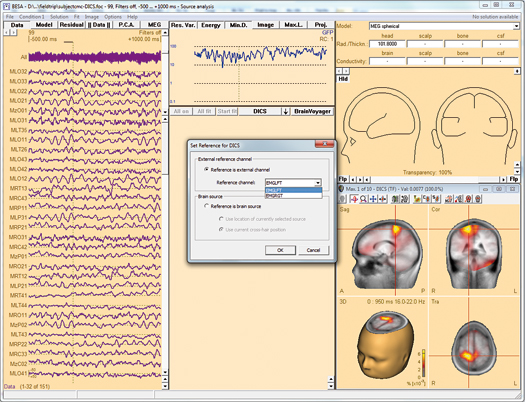Source coherence
Source coherence and time-frequency display
Source coherence analysis reveals the functional connectivity between brain regions. This is achieved by transforming the surface signals into brain activity using brain source montages derived from multiple source models. The new Source Coherence Module provides an extremely fast and user-friendly implementation of time-frequency analysis based on complex demodulation. Users can create event-related time-frequency displays of power, amplitude, or event-related (de)synchronization and coherence for the current montage using brain sources or surface channels. Induced and evoked activities can be separated.
Coherence can be calculated between any pair of locations in the brain

Time-frequency analysis
- Time-frequency diagrams based on surface or source channels
- Display of absolute power or spectral amplitude
- Display of event-related spectral perturbation (ERD / ERS) in percent
- Temporal-spectral information optimized by complex demodulation
- Visualization of inter-trial phase locking
- Variable setting of time-frequency resolution
- Separation of evoked and induced activity by subtraction of the averaged evoked activity from single trials
- Direct comparison of two conditions
Source coherence
- Oscillatory coupling between brain regions analyzed directly in brain source space using source montages
- Calculation of cross-spectral matrices between any combination of source (and / or surface) channels
- Event-related coherence displayed in time-frequency space
- Coherence analysis based on power and phase locking
- Computation and display of phase delay and latency difference between channels allowing inference on causality
- 3D Imaging of oscillatory activity using the BESA Mulitple Source Beamformer (MSBF) or Dynamic Imaging of Coherent Sources (DICS, Gross et al., 2001)
Statistical analysis
- Statistical probability maps based on resampling of the single trial data
- Statistics available for all time-frequency displays (absolute amplitude, TSE, coherence, comparison of conditions)
- Export of displayed data for offline statistics across subjects (e.g. in BESA Statistics or MATLAB)

Recent Comments